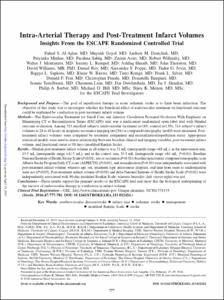KUMEL Repository
1. Journal Papers (연구논문)
1. School of Medicine (의과대학)
Dept. of Neurosurgery (신경외과학)
Intra-Arterial Therapy and Post-Treatment Infarct Volumes, Insights From the ESCAPE Randomized Controlled Trial
- Keimyung Author(s)
- Kim, Chang Hyun; Sohn, Sung Il
- Department
- Dept. of Neurosurgery (신경외과학)
- Journal Title
- Stroke
- Issued Date
- 2016
- Volume
- 47
- Issue
- 3
- Keyword
- Cerebrovascular disease/stroke; Infarct size; Ischemic stroke; Management; Modified Rankin Scale; Stroke
- Abstract
- Background and Purpose—The goal of reperfusion therapy in acute ischemic stroke is to limit brain infarction. The
objective of this study was to investigate whether the beneficial effect of endovascular treatment on functional outcome
could be explained by a reduction in post-treatment infarct volume.
Methods—The Endovascular Treatment for Small Core and Anterior Circulation Proximal Occlusion With Emphasis on
Minimizing CT to Recanalization Times (ESCAPE) trial was a multicenter randomized open-label trial with blinded
outcome evaluation. Among 315 enrolled subjects (endovascular treatment n=165; control n=150), 314 subject’s infarct
volumes at 24 to 48 hours on magnetic resonance imaging (n=254) or computed tomography (n=60) were measured. Posttreatment
infarct volumes were compared by treatment assignment and recanalization/reperfusion status. Appropriate
statistical models were used to assess relationship between baseline clinical and imaging variables, post-treatment infarct
volume, and functional status at 90 days (modified Rankin Scale).
Results—Median post-treatment infarct volume in all subjects was 21 mL (interquartile range =65 mL), in the intervention arm,
15.5 mL (interquartile range =41.5 mL), and in the control arm, 33.5 mL (interquartile range =84 mL; P<0.01). Baseline
National Institute of Health Stroke Scale (P<0.01), site of occlusion (P<0.01), baseline noncontrast computed tomographic scan
Alberta Stroke Program Early CT score (ASPECTS) (P<0.01), and recanalization (P<0.01) were independently associated with
post-treatment infarct volume, whereas age, sex, treatment type, intravenous alteplase, and time from onset to randomization
were not (P>0.05). Post-treatment infarct volume (P<0.01) and delta National Institute of Health Stroke Scale (P<0.01) were
independently associated with 90-day modified Rankin Scale, whereas laterality (left versus right) was not.
Conclusions—These results support the primary results of the ESCAPE trial and show that the biological underpinning of
the success of endovascular therapy is a reduction in infarct volume.
Clinical Trial Registration—URL: http://www.clinicaltrials.gov. Unique identifier: NCT01778335.
- Publisher
- School of Medicine
- Citation
- Fahad S. Al-Ajlan et al. (2016). Intra-Arterial Therapy and Post-Treatment Infarct Volumes, Insights From the ESCAPE Randomized Controlled Trial. Stroke, 47(3), 777–781. doi: 10.1161/STROKEAHA.115.012424
- Type
- Article
- ISSN
- 0039-2499
- Appears in Collections:
- 1. School of Medicine (의과대학) > Dept. of Neurosurgery (신경외과학)
- 파일 목록
-
-
Download
 oak-2016-0138.pdf
기타 데이터 / 1.24 MB / Adobe PDF
oak-2016-0138.pdf
기타 데이터 / 1.24 MB / Adobe PDF
-
Items in Repository are protected by copyright, with all rights reserved, unless otherwise indicated.